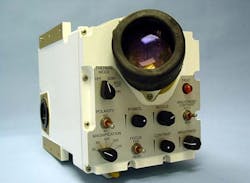Army chooses electro-optical turret imaging systems from Palomar for armored combat vehicle uses
Officials of the Army Contracting Command in Alexandria, Va., announced a $9.3 million contract to Palomar last week for additional production quantities of the company's Binocular Image Control Unit (BICU).
Palomar's family of binocular displays delivers large virtual images in small, rugged, militarized enclosures. The company's BICU presents a very large virtual image from a very small real image at the designed focal length.
A binocular lens uses both eyes to create a virtual image with desired eye relieve, eye pitch, pupil size, field view, magnification, and focal length.
The binocular display images at an invite focus to enable armored combat vehicle crew members to position their heads at any eye relief and maintain focus on information displayed on the screen. This reduces nausea while the vehicle is on the move on rough terrain, Palomar officials say.
Related: EO/IR sensors boost situational awareness
The total volume necessary for a binocular display is a fraction of the volume required to display a comparable image by a direct view flat panel display, company officials say.
It offers a brow pad on which users can place their heads at the proper distance from the binocular display and enables synchronized movement of the user and the display.
The Palomar BICU offers a dual display; ; dual display; bright, large, high quality images; small volume; large image, wide field of view provides high system optical magnification; combat proven designs that are highly reliable in military vehicle environments.
It has input power of plus-or-minus 15, plus 5, and plus 70 volts DC; power dissipation of 45 Watts, more than 500 foot-lamberts of brightness, symbology compatible with the day site, 32.2-degree field of view with normal eye relief, and 40.8-degree field of view with no eye relief. The unit has built-in test, weighs 29 pounds, and meeds military standards.
On this contract Palomar will do the work in various locations, depending on each order, and should be finished by February 2020. For more information contact Palomar Display Products online at www.palomardisplays.com.
Learn more: search the Aerospace & Defense Buyer's Guide for companies, new products, press releases, and videos
